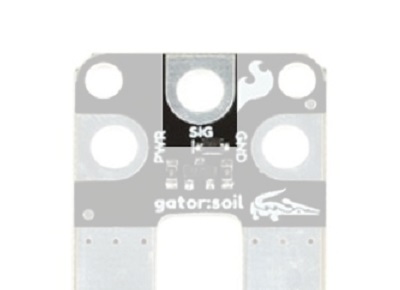SparkFun gator:soil Hookup Guide
Hardware Overview
The gator:soil consists of two probes and three pads (PWR, GND, and SIG).
| Contacts | Description |
|---|---|
| PWR | INPUT: Power to the sensor (3.3V - 5V). |
| SIG | OUTPUT: Analog voltage representing the conductivity between the probes. |
| GND | REFERENCE: Ground reference (0V). |
| Probes | Used to sample soil moisture content for sensor. |
Power
We recommend powering the gator:soil with between 3.3V - 5V. Please note that the analog value returned will vary depending on what voltage is provided for the sensor.
For use with the gator:bit (v2) and micro:bit, you should provide 3.3V through the PWR and GND pads. We recommend not powering the sensor constantly to reduce corrosion of the probes; this can be controlled through one of the digital pins of the gator:bit (v2).
Output Signal
The two probes are used to measure the conductivity of the soil. SIG provides an analog voltage out that can be attached to an ADC pad on the gator:bit (v2).
The value read on SIG is dependent several variables such as soil composition, contact on the probes, soil compaction, amongst other factors. For example, if you have a high alkaline content in your soil, it will be more conducive and give you a high baseline reading. In most cases, you will probably need to calibrate your sensor reading for each soil sample and sensor. Once calibrated, for a fixed sensor, the primary variables to the measure conductivity in the soil will be the power input and moisture content of the soil.

